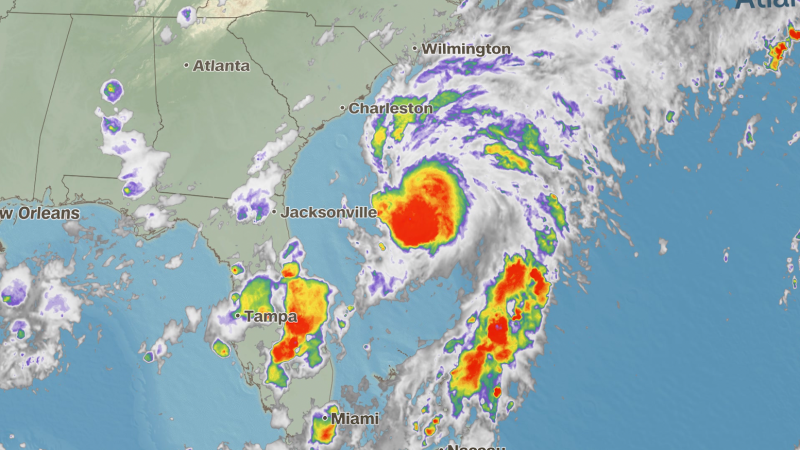Latest Update: Tropical Storm Chantal Brings Rain, Flash Flooding, and Disruptions to North and South Carolina, Impacting Travelers - Travel And Tour World
Sunday, July 6, 2025

As Tropical Storm Chantal moves toward the Carolinas and Georgia, the coasts and interior regions prepare for unpredictable weather this weekend. For some people, this storm brings back memories of how fast tropical systems can disrupt travel plans. If you’re a beach vacationer or a mountain climber, this storm brings its own difficulties for both tourists and residents. As the storm has the makings to have heavy rainfalls, powerful winds, and perilous surf situations, travelers headed to Carolinas, Georgia, and related areas need to prepare for possible disruption to their trips.
Tropical Storm Chantal developed on the Fourth of July from a low-pressure system over Florida and the coast of Georgia. Thanks to the warm waters of the Gulf Stream, the system intensified quickly into a tropical storm, catching many off-guard with its rapid development. By the time it approached the Carolinas, Chantal had already begun affecting coastal areas, bringing the risk of flash flooding, strong winds, and dangerous rip currents along beaches. The storm was expected to continue moving inland, affecting the Piedmont Triad of North Carolina and making its way through South Carolina by early Sunday morning.
As the storm tracked inland, its effects were expected to be less severe but still noticeable, particularly in the form of scattered thunderstorms and brief heavy rainfall. The system’s relatively short time over the ocean meant that it had limited power to bring widespread damage, but the timing of its landfall during a busy summer travel season made it all the more disruptive for tourists.
For the millions of tourists who flock to the beaches of the Carolinas and Georgia during the summer months, Tropical Storm Chantal brings an unfortunate set of circumstances. The storm’s first effects were felt along the coastal regions from Charleston, South Carolina, to Atlantic Beach, North Carolina. With periods of heavy rain, rough surf, and dangerous rip currents, beachgoers found their plans for sunbathing and swimming replaced with advisories to stay out of the water.
Local officials in South Carolina and North Carolina have issued advisories warning of the heightened risk of flash flooding and strong winds, which can be especially dangerous for those who aren’t familiar with the area’s coastal conditions. Although local economies are heavily reliant on tourism, the temporary disruptions caused by Chantal are nothing new for these areas, which are well-versed in preparing for tropical systems. For tourists, however, the decision to continue or postpone their beach plans requires careful consideration of safety, as even seasoned travelers can find themselves unprepared for the storm’s quick changes.
In many popular tourist destinations like Myrtle Beach, Charleston, and Wilmington, the storm’s impact has caused temporary closures of some beachside accommodations and attractions. While the worst of the weather is expected to subside by Monday, some travelers may find themselves having to reschedule activities or cut their vacations short. This uncertainty has forced local businesses to adapt quickly, either offering credits or refunds for those affected by the storm, or adjusting opening hours based on weather forecasts.
As Chantal moves inland, the storm is expected to weaken, but not before it delivers substantial rainfall across the Piedmont Triad region of North Carolina, including cities like Winston-Salem, Greensboro, and Burlington. The inland areas typically do not experience the same storm-related issues as the coastal regions, but they can still face significant disruptions due to heavy rain and gusty winds.
For tourists planning to visit the region for its cultural sites, outdoor adventures, or scenic drives through the Blue Ridge Mountains, the timing of the storm could not be worse. The forecasted thunderstorms and rainfall could make many popular hiking trails impassable, while outdoor activities like zip-lining, kayaking, and golfing may also be disrupted. For visitors to cities like Asheville or Durham, rain and wind may cause delays and cancellations of outdoor events and festivals.
Transportation to and from these areas could also be affected. While not expected to be as severe as the effects on the coast, the storm’s movement could cause delays in flights, trains, and buses as well. Visitors arriving or leaving North Carolina may face delays due to weather-related disruptions. As the storm moves northeast, it could also impact traffic on highways as some roads might become flooded or obstructed due to storm debris. For many tourists, the challenge is figuring out how to navigate an area they may not be familiar with while dealing with an unexpected tropical storm.
In addition to disrupting coastal and urban tourism, Tropical Storm Chantal could also have far-reaching effects on more rural and remote areas of the Carolinas and Georgia. Many small towns in these regions depend on tourism to sustain local economies, particularly in areas like the North Carolina Sandhills and Georgia’s coastal islands. These areas are less prepared for tropical storms and face unique challenges due to their reliance on cash-based economies and seasonal visitors.
While the storm may bring beneficial rain to some agricultural communities, there’s a downside for the tourism industry. Local inns, bed-and-breakfasts, and smaller hotels in rural areas may experience cancellations or declines in reservations as travelers choose to stay away until the storm clears. For these businesses, which are already operating on slim margins during the slower parts of the year, any storm-related losses can be substantial.
Small businesses in rural areas may also face damage from the storm, and there could be logistical challenges to getting supplies or reopening after the storm has passed. Many tourists who had planned to visit these lesser-known destinations may opt for more urban environments, avoiding the risks posed by flash flooding, impassable roads, or power outages. This could lead to a temporary economic dip in regions that rely on tourism for a significant portion of their income.
For those planning to travel to the affected areas, flexibility and preparation are key. Tourists who are still planning to visit the coastal areas or inland regions of the Carolinas and Georgia should monitor local weather reports and adjust their itineraries as necessary. Many destinations offer real-time updates on road closures, beach conditions, and other travel advisories, and tourists should take advantage of these resources to stay informed.
When possible, travelers should also consider adjusting their travel dates to avoid the worst of the storm. If you are already in the area and your plans are disrupted, it is advisable to stay in touch with your accommodations and check on available options for rescheduling or refunds.
Looking Ahead: Tourism Recovery After the Storm
Once Tropical Storm Chantal moves out of the Carolinas and Georgia, the recovery process will begin. While the immediate impact on tourism may be significant in terms of cancellations and disruptions, the region will likely rebound quickly. Coastal communities are resilient, and many businesses have learned from past experiences, improving their preparedness and emergency response strategies.
It’s back to business for travelers after the storm has cleared when checking in with local tourism boards to learn if attractions, restaurants, and events are reopening. The recovery takes a day or two at most, but as with all things Carolina and Georgia, their popularity as a travel region endures.
«Enjoyed this post? Never miss out on future posts by following us»







